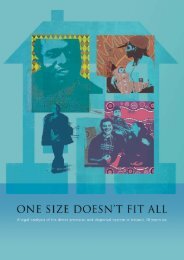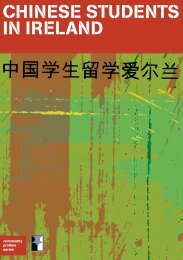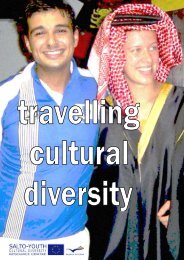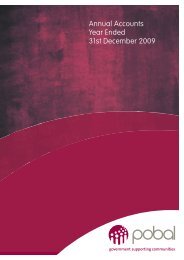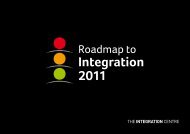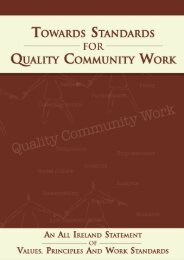Intercultural Education in the Post-Primary School - National Council ...
Intercultural Education in the Post-Primary School - National Council ...
Intercultural Education in the Post-Primary School - National Council ...
You also want an ePaper? Increase the reach of your titles
YUMPU automatically turns print PDFs into web optimized ePapers that Google loves.
that people of different cultures can andshould be able to engage with each o<strong>the</strong>rand learn from each o<strong>the</strong>r.<strong>Education</strong> not only reflects society but isalso an <strong>in</strong>fluence <strong>in</strong> shap<strong>in</strong>g itsdevelopment. As such, schools are one of<strong>the</strong> <strong>in</strong>stitutions that have a role to play <strong>in</strong><strong>the</strong> development of an <strong>in</strong>tercultural society.While education cannot bear <strong>the</strong> soleresponsibility for challeng<strong>in</strong>g racism andpromot<strong>in</strong>g <strong>in</strong>tercultural competence, it hasan important contribution to make <strong>in</strong>facilitat<strong>in</strong>g <strong>the</strong> development of <strong>in</strong>terculturalskills, attitudes, values and knowledge.An <strong>in</strong>tercultural education is valuable toall students <strong>in</strong> equipp<strong>in</strong>g <strong>the</strong>m toparticipate <strong>in</strong> an <strong>in</strong>creas<strong>in</strong>gly diverseIreland, Europe and global society. Equally,an education that has a limited culturalfocus will be less likely to develop <strong>the</strong>secapacities <strong>in</strong> students.In Guidel<strong>in</strong>es on Traveller <strong>Education</strong> <strong>in</strong>Second Level <strong>School</strong>s, (pp.20-21) <strong>the</strong>Department of <strong>Education</strong> and Science(2002) has def<strong>in</strong>ed <strong>in</strong>tercultural educationas aim<strong>in</strong>g to:• foster conditions conducive to pluralism<strong>in</strong> society• raise pupils’ awareness of <strong>the</strong>ir ownculture and to attune <strong>the</strong>m to <strong>the</strong> factthat <strong>the</strong>re are o<strong>the</strong>r ways of behav<strong>in</strong>gand o<strong>the</strong>r value systems• develop respect for lifestyles differentfrom <strong>the</strong>ir own so that pupils canunderstand and appreciate each o<strong>the</strong>r• foster a commitment to equality;• enable pupils to make <strong>in</strong>formed choicesabout, and to take action on, issues ofprejudice and discrim<strong>in</strong>ation• appreciate and value similarities anddifferences;• enable all pupils to speak for <strong>the</strong>mselvesand to articulate <strong>the</strong>ir cultures andhistories.Some key features of <strong>in</strong>terculturaleducation are:• <strong>Intercultural</strong> education is for all studentsirrespective of <strong>the</strong>ir ethnicity. S<strong>in</strong>ce allour students live <strong>in</strong> a country and aworld that is becom<strong>in</strong>g <strong>in</strong>creas<strong>in</strong>glydiverse, we need to prepare <strong>the</strong>m forthat world. <strong>Intercultural</strong> education is animportant part of every student’seducational experience whe<strong>the</strong>r he/she is<strong>in</strong> a school which is characterised byethnic diversity, <strong>in</strong> a predom<strong>in</strong>antlymono-ethnic school, or whe<strong>the</strong>r <strong>the</strong>student is from <strong>the</strong> dom<strong>in</strong>ant or am<strong>in</strong>ority culture.• <strong>Intercultural</strong> education is for all studentsirrespective of <strong>the</strong>ir age. Recognis<strong>in</strong>gthat diversity is normal <strong>in</strong> humans issometh<strong>in</strong>g that is appropriate at all ages.• Dialogue and story are identified asfundamental components of <strong>in</strong>terculturaleducation. While it is important to giveyoung people accurate <strong>in</strong>formation andto challenge stereotypes andmisconceptions, equipp<strong>in</strong>g <strong>the</strong>m with<strong>in</strong>tercultural capacity is more effectiveif it is done through open dialoguewhich allows <strong>the</strong>m to express <strong>the</strong>irthoughts, fears and perceptions ra<strong>the</strong>rthan simply tell<strong>in</strong>g <strong>the</strong>m <strong>the</strong> ‘right andwrong’ of <strong>the</strong> situation.• <strong>Intercultural</strong> education happensnaturally through <strong>the</strong> ‘hiddencurriculum’ of <strong>the</strong> social and visualworld with<strong>in</strong> which <strong>the</strong> student learns.While it is possible and necessary to<strong>in</strong>clude <strong>in</strong>tercultural ideas <strong>in</strong> <strong>the</strong> taught‘formal curriculum’, <strong>the</strong> images,messages and values that are conveyedthroughout <strong>the</strong> school culture are alsocrucial. In explor<strong>in</strong>g <strong>the</strong> hiddencurriculum it is important to note thatwhat is absent can be as important aswhat is present.• <strong>Intercultural</strong> education is concerned wi<strong>the</strong>thnicity and culture and not simply withsk<strong>in</strong> colour. <strong>Intercultural</strong> education wouldii<strong>Intercultural</strong> <strong>Education</strong> <strong>in</strong> <strong>the</strong> <strong>Post</strong>-<strong>Primary</strong> <strong>School</strong>








